
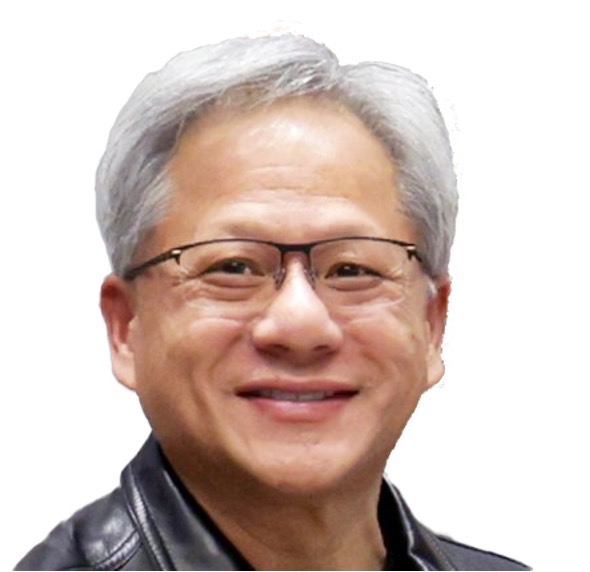 Jensen Huang, Nvidia photo.
Jensen Huang, Nvidia photo.
This is Part Three of the Plato and Young Icarus series. Part One set out the debate in neoclassical terms between the elders would slow down AI and the young who would speed it up. Part Two shared the story of the visionary herald of AI. Ray Kurzweil: Google’s prophet of superintelligent AI who will not slow down. In Part Three we share the story of Jen-Hsun “Jensen” Huang, the CEO and founder of NVIDIA, the U.S. chip manufacturer that makes super AI possible.
NVIDIA, now valued at over $1.3 Trillion, designs and builds new types of specialized, super-fast, neural net imitating chips. Jen-Hsun Huang, who now goes by Jensen Huang, faced great adversity as a nine-year old immigrant. He overcame these challenges to start Nvidia twenty years later. Jensen fears business failure, not AI, which he knows like the back of his hand. All the leading AI software companies like OpenAI and Google need his hardware for their LLM software to work. He and his scientist and engineers at Nvidia know more about what is going on in the AI industry that anyone. Here is Nvidia’s 2023 marketing video that shows what they do. Click image or here to see to see the video.
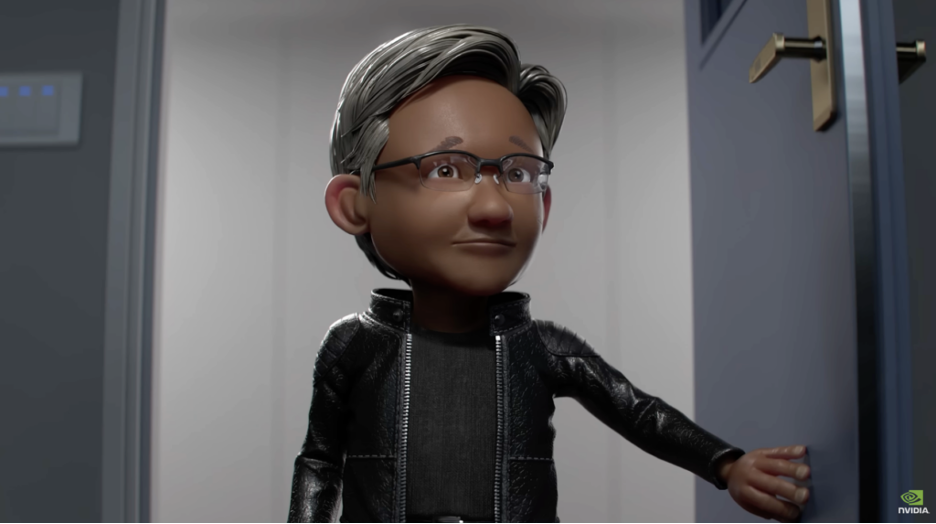 Meet NVIDIA — The Engine of AI. Short music video explanation of the company.
Meet NVIDIA — The Engine of AI. Short music video explanation of the company.
Nvidia helps all other companies to manufacture intelligence. So when Jensen Huang predicted on November 30, 2023, that AGI would be attained in five years, 2028, a year before Kurzweil’s prediction, the whole world took notice. Watch him make this prediction in the video below when he answered a question by New York Times reporter, Andrew Sorkin, at the November 30, 2023, NY Times Deal Book Summit. Click image or here to see to see the video.
As will be shown in this article, Jensen Huang also supports reasonable product regulation and safety certification, in the manner that has already been done successfully with other potentially dangerous products, such as aviation and automobiles. He also describes how AGI will increase and improve employment, and bring greater prosperity to all willing to learn.
The Incredible Story and Character of Jensen Huang
Jensen himself is a very impressive person with a rags to riches immigrant story that reads like a graphic novel. Jensen recently revealed new details of his story to Stephen Witt, author of the The New Yorker article. How Jensen Huang’s Nvidia Is Powering the A.I. Revolution, (The New Yorker, 11/27/23). Born in 1973 in Taiwan as Jen-Hsun Huang, his parents soon moved to Thailand. Due to the dangers caused by the dramatic end of the Vietnam War, his parents were forced to send him and his older brother, alone, to an uncle in the U.S.
They made it through immigration somehow, but the uncle sent Jen-Hsun Huang, age nine, and his brother, away to what he thought it was a good, private, yet surprisingly affordable boarding school. Wrong. It was actually a notorious reform school in rural Kentucky, a living hell for anyone sent there. It was especially bad for these two undersized Asian immigrants with long hair and heavily accented English.
 Two happy Asian kids arrive at a reform school right off the boat thinking it’s an exclusive private boarding school in Kentucky. Image depicted in graphic novel style using Visual Muse by Ralph Losey.
Two happy Asian kids arrive at a reform school right off the boat thinking it’s an exclusive private boarding school in Kentucky. Image depicted in graphic novel style using Visual Muse by Ralph Losey.
They had been taught a kind of English by their mother, who did not actually speak or even understand the language, but she had a book, from which she would pick ten random words every day for them to learn. The Huang boys in the back woods of Kentucky were perfect targets at a school for juvenile delinquents. In the New Yorker interview Jen-Hsun admitted that he was at first attacked daily, even stabbed. Knife attacks were common in this religious reform school in Kentucky where many were illiterate, and all smoked cigarettes, except for the Huangs. He and his older brother were subject to constant ethnic slurs, harassment and bullying, often life threatening. Jen-Hsun survived. Little Huang used his wits and he exercised. He eventually did one hundred push-ups every night and learned how to defend himself. He also helped other kids with homework.
In an earlier interview with Stratechery, Jen-Hsun said he was nine and brother eleven when they arrived and they were happy to be there. But he did admit that his brother was forced to work on tobacco farms and that he was forced to clean bathrooms, alone and unpaid. You’d have to call it child, slave labor. He thought that was normal in America, the land of opportunity. So he learned to work hard and survive bullying with a smile.
 Lille kid forced to clean bathrooms alone thinking that was the American way. Depicted in graphic novel style using Visual Muse by Ralph Losey.
Lille kid forced to clean bathrooms alone thinking that was the American way. Depicted in graphic novel style using Visual Muse by Ralph Losey.
Two years or so later, his parents were able to immigrate to the United States, realized their kids’ situation and rescued them. Amazingly in 2019 by then billionaire Jensen Huang donated money to the school for a new building. No hard feelings I guess. Of course, Jen-Hsun also quietly promotes Asian-American rights, where racist discrimination continues to this day throughout the United States.
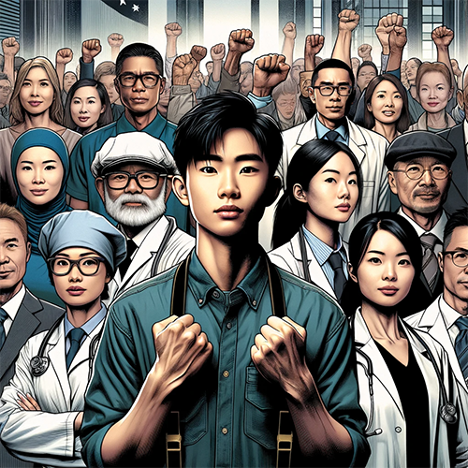 Asian American equal rights image portrayed in a combined graphic novel and photo realism style using Visual Muse by Ralph Losey.
Asian American equal rights image portrayed in a combined graphic novel and photo realism style using Visual Muse by Ralph Losey.
I am sure Jen-Hsun’s inner strength and determination also has a lot to do with his strong family values. He and his brother must have been very happy when their father (an engineer in Taiwan) and mother were finally able to immigrate to the U.S. and rescue their sons.
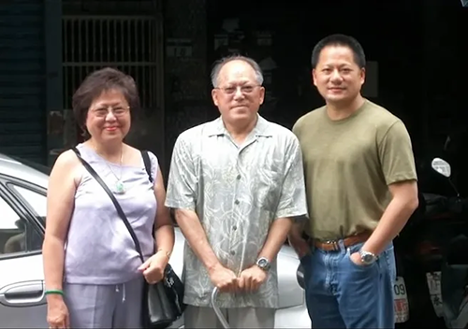 Jen-Hsun Huang and his parents, Sidney and Maria Huang. Date unknown. Nvidia photo.
Jen-Hsun Huang and his parents, Sidney and Maria Huang. Date unknown. Nvidia photo.
Upon his escape from the reform school and reuniting with his parents, Jensen attended Aloha High School just outside Portland. He graduated a year early and was also a nationally ranked table-tennis player. Jensen then went to Oregon State University and graduated in 1984. He met his future wife to be there, Lori Mills, who was his lab partner. Lori graduated from Oregon in 1985, also with an electrical engineering degree. Sometime after graduation they married, and both found work in Silicon Valley as microchip designers. Jensen likes to share that Lori made more money than he did at their first engineering jobs.
In a few years, Lori left the workforce to raise their two children. By then, Huang was running his own division at LSI Logic and attending graduate school at Stanford at night. He earned a master’s degree in electrical engineering in 1992.
 Jensen and Lori at Jensen’s graduation. Nvidia photo.
Jensen and Lori at Jensen’s graduation. Nvidia photo.
Seven years later, ever courageous Jensen left his comfortable job to start his own chip company, Nvidia, at age twenty-nine. Jensen loved video games and his original idea was to specialize in design and manufacture of graphics chips to make the game graphics run better. He started Nvidia with two other, older chip designer friends, Chris Malachowsky, a University of Florida graduate, my law school alma mater, and Curtis Priem. They had only $40,000 between them to start the company. They decided Jensen should be the CEO because Chris and Curtis knew he was a fast learner. This all happened at a Denny’s restaurant booth, which Jensen often used at the start as an office. He had worked at Denny’s in Oregon in the 1980s as a dishwasher and busboy. The rest, as they say, is history. Nvidia is now the sixth largest company in the world. How Jensen Huang’s Nvidia Is Powering the A.I. Revolution.
With their kids now grown Lori Huang serves as the president of the Jen-Hsun and Lori Huang Foundation, supporting higher education, public health, and STEM initiatives across the U.S. Here is a photo of them in 2022 at which time they had just donated $50 Million to their alma mater, Oregon State University.
 Lori and Jensen Huang. Oregon State photo on occasion of their donation of $50M to the school.
Lori and Jensen Huang. Oregon State photo on occasion of their donation of $50M to the school.
Huang and NVIDIA
As a result of Jensen’s childhood struggles as an immigrant, including life threatening attacks, he learned to thrive under grave pressure. He now has tremendous inner strength, drive and focus, along with a confident, low-key sense of humor. He literally thrives on great adversity, gets into the flow, concentrates and does his best work. This probably explains why the unofficial motto of the Nvidia is “Our company is thirty days from going out of business.” He used to open all of his big employees talks by saying this. It became expected. His calm, inner-warrior, super-hero persona came out in the recent NY Times, 2023 DealBook summit interview below. Click image or here to see to see the video.
 CLICK IMAGE TO SEE VIDEO OF INTERVIEW. Jensen Huang learned to thrive on adversity at an early age, including dangerous crossings of a rickety bridge in Kentucky. Here shown as hero saving his company using graphic novel style and Visual Muse by Ralph Losey.
CLICK IMAGE TO SEE VIDEO OF INTERVIEW. Jensen Huang learned to thrive on adversity at an early age, including dangerous crossings of a rickety bridge in Kentucky. Here shown as hero saving his company using graphic novel style and Visual Muse by Ralph Losey.
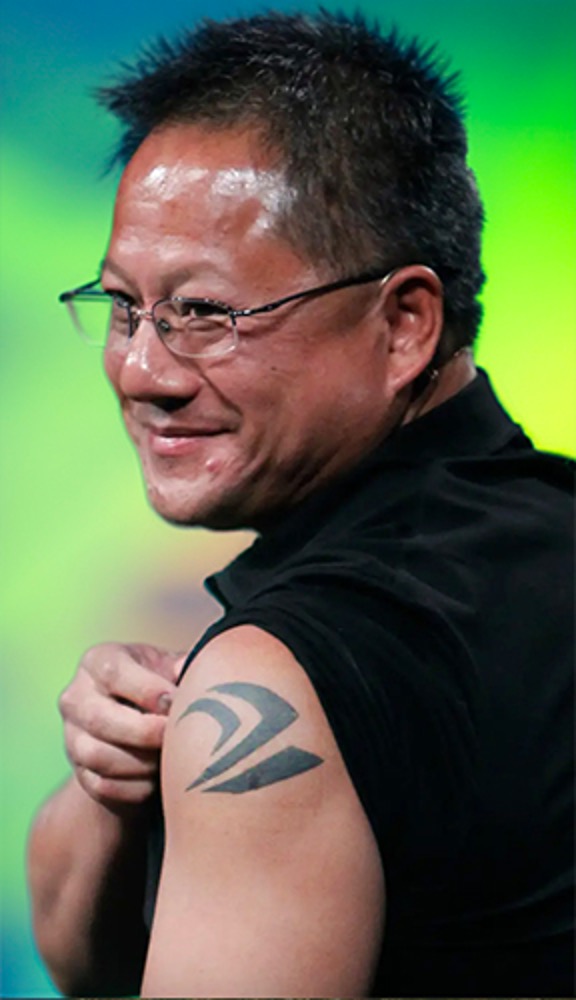 Jensen Huang shows
Jensen Huang shows
off his Nvidia logo tattoo.
Robert Galbraith, Reuters.
Jensen Huang loves his company, he even put a tattoo of the Nvidia company logo on his arm when the stock price hit 100. The stock price is now past 480. Jensen whines that he’ll never get another tattoo because it hurts too much, far more than his kids said it would! Unlike other tech billionaires, Jensen Huang is still a family man. His two children now work for Nvidia.
Jensen is also unusual in that his employees all seem to love him and his hard working, self-effacing style. I am sure the great pay helps too! His witty personality shows in his hands-on, creative management style, which includes writing hundreds of very short emails every day to the fifty employees who report directly to him. That’s right, fifty direct reports. This is an unprecedented number of employees to report directly to a CEO. Most corporations have six to ten direct reports. The Nvidia leaders say, without revealing any content, that his emails are very short, and poetic, like Haikus or one said, laughing, like ransom notes. The direct reports submit short lists to him every week of the five most important things they’re working on. He reads each report late the same night. Then he often shows up at their offices unannounced to talk to them about it. Stephen Witt, How Jensen Huang’s Nvidia Is Powering the A.I. Revolution, (The New Yorker, 11/27/23). Yes, he’s a very hard worker, and he likes what he’s doing now far better than cleaning toilets in a reform school.
Jensen is intense and sometimes has a temper, but is naturally affable, and due to his superintelligence, is a modest, creative-type boss. You can tell from the videos and his actions. Although Jensen Huang is now personally worth over Forty Billion Dollars, and is CEO of one of the most important Trillion Dollar corporations in the world, he still seems to be a genuine, kind-hearted person. Plus, many people, myself included, love his modest, deadpan sense of humor.
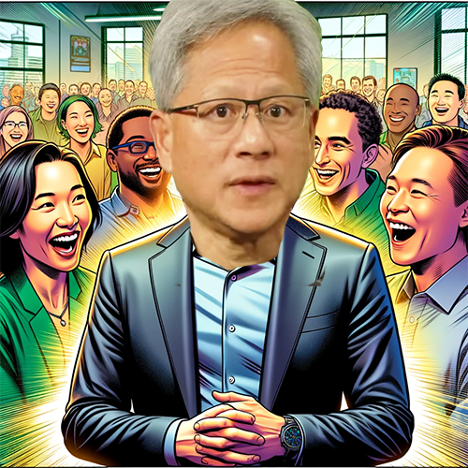 Jensen image in a style merging a photo with a Visual Muse graphic novel style drawing of employees laughing at his deadpan jokes by Ralph Losey.
Jensen image in a style merging a photo with a Visual Muse graphic novel style drawing of employees laughing at his deadpan jokes by Ralph Losey.
About the only thing bad I can say about him is that he doesn’t like science fiction, but he makes up for that by his love of video games. His employees must also love and appreciate the wealth that working for Nvidia has brought. Most of his long-term employees are by now very wealthy. They keep on working anyway for love of the job, the company, its leader and its mission. By the way, Jensen does not object to remote work and Nvidia’s beautiful, state of the art million square foot headquarters in Santa Clara is never full.
 Interior of Nvidia Headquarters. Courtesy Nvidia newsroom, Gensler – Jason O’Rear photography.
Interior of Nvidia Headquarters. Courtesy Nvidia newsroom, Gensler – Jason O’Rear photography.
On November 30, 2023, during an on-stage interview of Jensen Huang by New York Times reporter, Andrew Sorkin, Jensen revealed an important insight into his courageous character and bold business operations. Jensen Huang of Nvidia on the Future of A.I. | DealBook Summit 2023. This ties in nicely with the classical myth of young Icarus and his cautious Dad, Daedalus, that began this series on fear of AI. In truth they are both right in some respects. Plato and Young Icarus Were Right: do not heed the frightening shadow talk giving false warnings of superintelligent AI – Part One. Click image or here to see to see the video.
 CLICK IMAGE TO SEE VIDEO OF INTERVIEW excerpt from the NYT video. Image portrays naive teenager attitude of “How hard could it be?” The Courage and Confidence of Youth to Fly to the Sun. Icarus and Daedalus depicted in graphic novel style using Visual Muse by Ralph Losey.
CLICK IMAGE TO SEE VIDEO OF INTERVIEW excerpt from the NYT video. Image portrays naive teenager attitude of “How hard could it be?” The Courage and Confidence of Youth to Fly to the Sun. Icarus and Daedalus depicted in graphic novel style using Visual Muse by Ralph Losey.
The brave character of Jensen, forged as a little kid in a fire of immigrant adversity, enabled him to boldly lead Nvidia to conceive and build a new type of computer, one that takes us into the bright fire of superintelligence. Nvidia has already been flying with these Icarus wings of AI for years. That is how Nvidia was able to reinvent computing and transform the computer industry. Nvidia used AI to design and build its supercomputers that all high-tech companies of the world now crave. In another excerpt from the excellent NYT interview, you can hear Jensen’s own description of the new breakthrough heights to which Nvidia computers have flown. This is very important information here. I suggest you listen to this a few times, and moreover listen to the entire interview by Andrew Sorkin, shown on this clip. Click image or here to see to see the video.
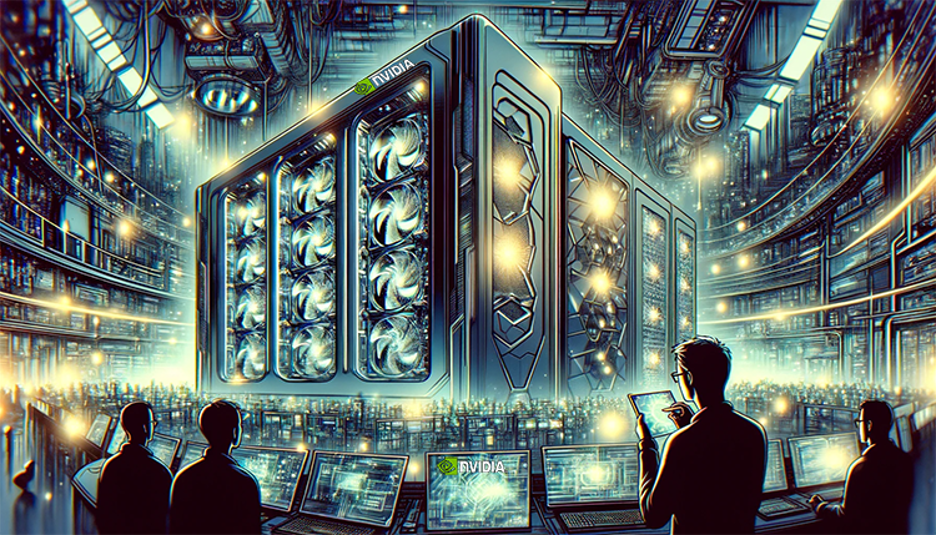 CLICK IMAGE of depicting a Nvidia Supercomputer in graphic novel style using Visual Muse by Ralph Losey. This video excerpt of the NYT video shows Jensen Huang described the new type of computer system Nvidia is building. Excerpt from NYT’s A.I. | DealBook Summit 2023.
CLICK IMAGE of depicting a Nvidia Supercomputer in graphic novel style using Visual Muse by Ralph Losey. This video excerpt of the NYT video shows Jensen Huang described the new type of computer system Nvidia is building. Excerpt from NYT’s A.I. | DealBook Summit 2023.
As Jensen Huang says: “We are in the beginning of a brand-new generation of computing.” This is the first reinvention of computing in sixty years. Jensen has touched the sun and come back to Plato’s cave of old technology to share his new knowledge.
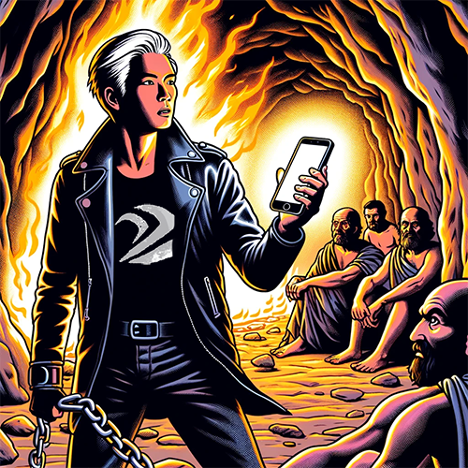 Jensen returns to Plato’s cave with an AI computing device depicted in graphic novel style using Visual Muse by Ralph Losey.
Jensen returns to Plato’s cave with an AI computing device depicted in graphic novel style using Visual Muse by Ralph Losey.
Jensen is trying to tell people, “Everyone is a programmer now. You just have to say something to the computer.” Nvidia chief Jensen Huang says AI is creating a ‘new computing era’ (Financial Post, 5/30/23). For more details watch Huang’s two hour Keynote at the 2023 Nvidia annual conference.
AI Safety, Regulation and Full Employment
Jensen Huang views of safety, regulation and employment are sophisticated and convincing. They echo the thoughts of Ray Kurzweil, but they do so based on his experience as one of the most successful entrepreneurs of our era. Stephen Witt in his article, How Jensen Huang’s Nvidia Is Powering the A.I. Revolution, observes and quotes Jensen, and two of his direct reports, on the subject of AI safety.
He has never worried about the (potential dangers of AI) technology, not once. “All it’s doing is processing data,” he said. “There are so many other things to worry about.” . . .
When I questioned them (Huang’s lead AI researcher, Catanzaro, and lead software developer, Diercks) about the wisdom of creating superhuman intelligence they looked at me as if I were questioning the utility of the washing machine. I had wondered aloud if an A.I. might someday kill someone. “Eh, electricity kills people every year,” Catanzaro said. I wondered if it might eliminate art. “It will make art better!” Diercks said. “It will make you much better at your job.” I wondered if someday soon an A.I. might become self-aware. “In order for you to be a creature, you have to be conscious. You have to have some knowledge of self, right?” Huang said. “I don’t know where that could happen.”
How Jensen Huang’s Nvidia Is Powering the A.I. Revolution
This was also discussed in the NYT interview. Here is the relevant excerpt where Huang talks about regulation of AI as a product, like we inspect airplanes and regulate flight with the FAA. Click image or here to see the video on YouTube.
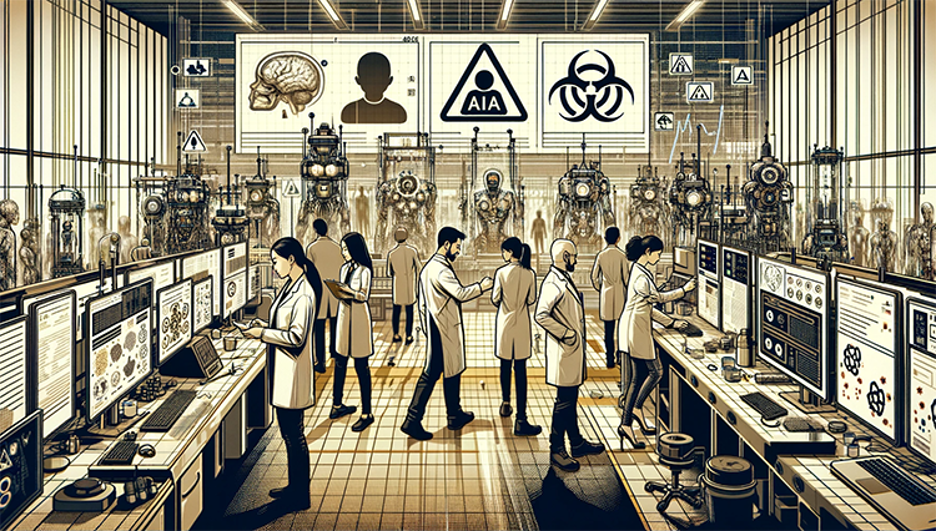 Huang on AI Safety Regulations. Excerpt from NYT’s A.I. | DealBook Summit 2023. Graphic novel style image of a AI product and safety testing lab using Visual Muse by Ralph Losey.
Huang on AI Safety Regulations. Excerpt from NYT’s A.I. | DealBook Summit 2023. Graphic novel style image of a AI product and safety testing lab using Visual Muse by Ralph Losey.
For more insights into Huang’s reasonably cautious attitude on AI safety and regulation, we turn to the lengthy Acquired Interview of Jensen Huang in late October 2023. Here Jensen responds to questions by young podcasters related to the supposed danger of AI, especially employment loss. Jensen Huang’s spontaneous, often funny language flow provides a good glimpse into how he thinks.
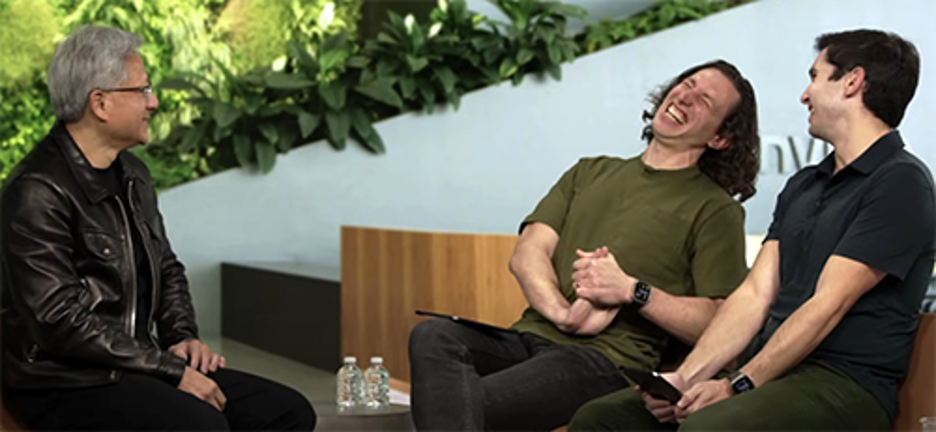 Screenshot of Acquired Interview of Jensen Huang on Safety and Jobs.
Screenshot of Acquired Interview of Jensen Huang on Safety and Jobs.
Well, first of all we have to keep AI safe. There are a couple of different areas of AI safety that are really important. Obviously, in robotics and self-driving cars, there is a whole field of AI safety and we’ve dedicated ourselves to functional safety and active safety and all kinds of different areas of safety. When to apply human in the loop, when is it ok for the human not to be in the loop. How do you get to a point where, increasingly, human doesn’t have to be in the loop, but human is largely in the loop. In the case of information safety: obviously bias, false information and then appreciating the rights of artists and creators, that whole area deserves a lot of attention. You’ve seen some of the work that we’ve done. Instead of scraping the internet, we partnered with Getty and Shutterstock to create a commercially fair way of applying artificial intelligence in terms of AI.
In the area of Large Language Models and their future of increasingly greater agency AI, clearly the answer is for as longs as its sensible, and I think its going to be sensible for a long time, is human in the loop. The ability for an AI to self-learn and improve and change out in the wild in the digital form should be avoided. We should collect data, carry the data, train the model, we should test the model, validate the model, before we release it out in the world again. So human is in the loop. . . .
With respect to automation, my feeling is that, and we’ll see, but it is more likely that AI is going to create more jobs in the near term. The question is what’s the definition of near term. The reason for that is, the first thing that happens with productivity is prosperity. With prosperity, then the companies get more successful, they hire more people because they want to expand into more areas. So the question is, if you think about a company and say, if we improve the productivity then they need fewer people. Well, that’s because the company has no more ideas. (interviewers laugh) But that’s not true for most companies. If you become more productive and the company becomes more profitable, then, usually, they hire more people to expand into new areas. So long as we believe that there are more areas to expand into – there are more ideas in drug discoveries, more ideas in transportation, there are more ideas in retail, more ideas in entertainment, that there’s more ideas in technology. So long as we believe that there are more ideas, the prosperity of the industry, which comes from improved productivity, results in hiring more people, more ideas.
Now go back in history, we can fairly say that today’s industry is larger than the world’s industries a thousand years ago. The reason for that is because obviously humans have a lot of ideas. I think that there’s plenty of ideas yet for prosperity and plenty of ideas that can begat from productivity improvements, and my sense if that it is likely to generate jobs. Now obviously net generation of jobs doesn’t guaranty that any one human doesn’t get fired. Ok. That’s obviously true. It’s more likely that someone will lose a job to someone else, some other human, that uses an AI. Not likely to an AI, but to some other human that uses an AI. So, I think that the first thing that everybody should do is learn how to use AIs, so that they can augment their own productivity. . . .
I think jobs will change. My guess is that we’ll actually have higher employment, we’ll create more jobs. I think industries will be more productive. Many of the industries that are currently suffering from lack of labor, workforce, are likely to use AI to get themselves off their feet, and get back to growth and prosperity. So I see it a little bit differently but I do think jobs will be effected and I’d just encourage everybody to learn AI.
Acquired Interviews, NVIDIA CEO Jensen Huang (10/23) at 1:00:11 – 1:05:20.
So the message here is that AI will create more jobs than it replaces, but the new jobs will require knowledge of AI and AI tools. There are many free education resources online. One good place to look that we just discovered is NVIDIA On Demand, which has many instructional videos.
This concludes Part Three of the Plato and Young Icarus series. Part Four is coming soon.
All kinds of people learning AI depicted in Graphic novel style using Visual Muse by Ralph Losey.